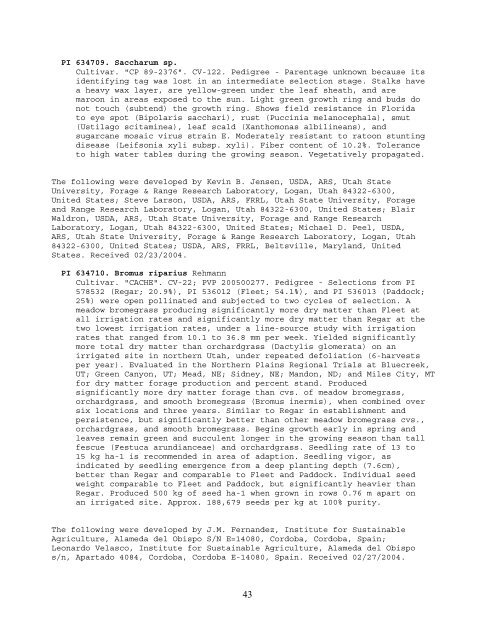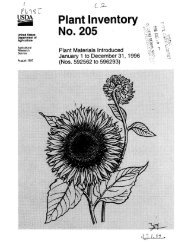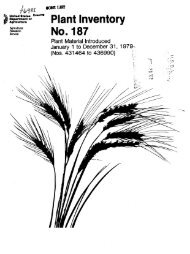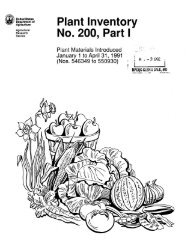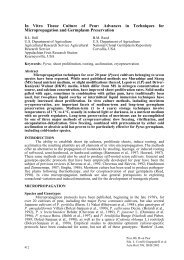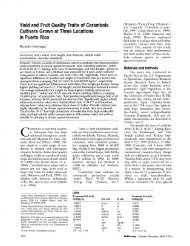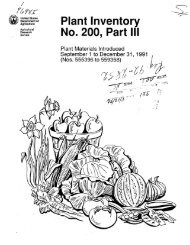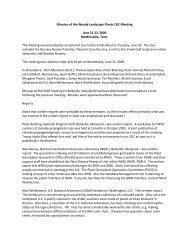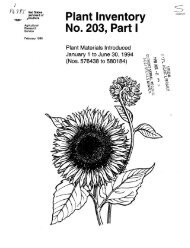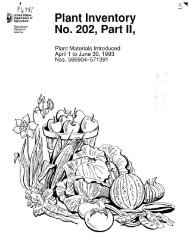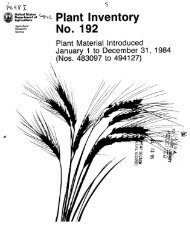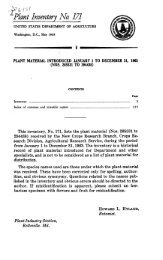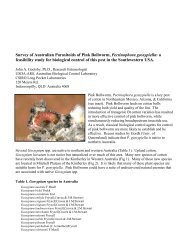<strong>The</strong> following were donated by Will Bonsall, Scatterseed Project, 39 BaileyRoad, Industry, Maine 04938, United States. Received 05/16/2000.PI 634706. Cucurbita moschata DuchesneUncertain. CP-00-01; Grif 14475. Collected 1999 in Sri Lanka. From SouthRatnayake, Dambulla. Large fruited.<strong>The</strong> following were developed by Barry Glaz, USDA, ARS, Sugarcane FieldStation, Canal Point, Florida 33438, United States; John Dunckelman, FloridaSugar Cane League, P.O. Drawer 1208, Clewiston, Florida 33440, United States;Jimmie D. Miller, USDA, ARS, Sugarcane Field Station, Star Route Box 8, CanalPoint, Florida 33438, United States; Jack C. Comstock, USDA, ARS, USSugarcane Research Field Station, 12990 US Hwy 441 N, Canal Point, Florida33438, United States; Robert A. Gilbert, University of Florida, EREC, 3200East Palm Beach Road, Belle Glade, Florida 33430-8003, United States; S.Edme, USDA-ARS, Sugarcane Field Station, 12990 US Highway 441N, Canal City,Florida 33438, United States; J. Davidson, Florida Sugar Cane League, Inc.,P.O. Box 1208, Clewiston, Florida 33440, United States. Received 02/20/2004.PI 634707. Saccharum sp.Cultivar. "CP 94-1340". CV-118. Pedigree - Selected from progeny of thecross CP 87-1733/CP 86-1665. Stalks green and leaves have long ligules.Field resistance to eyespot (Bipolaris sacchari), smut (Ustilagoscitaminea), leaf scald (Xanthomonas albilineans), and sugarcane virusstrain E. Inoculated test results indicate moderately susceptible to ratoon stunting disease (Leifsonia xyli subsp. xyli). Fiber content 9.8%.Vegetatively propagated.<strong>The</strong> following were developed by Barry Glaz, USDA, ARS, Sugarcane FieldStation, Canal Point, Florida 33438, United States; P.Y.P. Tai, USDA-ARS,Sugarcane Field Station, Star Route Box 8, Canal Point, Florida 33438, UnitedStates; John Dunckelman, Florida Sugar Cane League, P.O. Drawer 1208,Clewiston, Florida 33440, United States; Jimmie D. Miller, USDA, ARS,Sugarcane Field Station, Star Route Box 8, Canal Point, Florida 33438, UnitedStates; Jack C. Comstock, USDA, ARS, US Sugarcane Research Field Station,12990 US Hwy 441 N, Canal Point, Florida 33438, United States; Robert A.Gilbert, University of Florida, EREC, 3200 East Palm Beach Road, Belle Glade,Florida 33430-8003, United States; S. Edme, USDA-ARS, Sugarcane FieldStation, 12990 US Highway 441N, Canal City, Florida 33438, United States; J.Davidson, Florida Sugar Cane League, Inc., P.O. Box 1208, Clewiston, Florida33440, United States. Received 02/20/2004.PI 634708. Saccharum sp.Cultivar. "CP 94-1100". CV-119. Pedigree - Progeny of the cross CP81-1238 (PI 578048) / CP 88-2045. Stalks have a brownish-green color andare partially self stripping. Field resistance to eye spot (Bipolarissacchari), smut (Ustilago scitaninea), and to sugarcane mosaic strain E.Inoculated tests results indicate moderately susceptible to ratoon stunting disease (Leifsonia xyli subsp. xyli) and to leaf scald(Xanthomonas albilineans). A low frequency of small rust pustules(Puccinia melanocephala) was observed. Fiber content 9.7%. Vegetativelypropagated.42
PI 634709. Saccharum sp.Cultivar. "CP 89-2376". CV-122. Pedigree - Parentage unknown because itsidentifying tag was lost in an intermediate selection stage. Stalks havea heavy wax layer, are yellow-green under the leaf sheath, and aremaroon in areas exposed to the sun. Light green growth ring and buds donot touch (subtend) the growth ring. Shows field resistance in Floridato eye spot (Bipolaris sacchari), rust (Puccinia melanocephala), smut(Ustilago scitaminea), leaf scald (Xanthomonas albilineans), andsugarcane mosaic virus strain E. Moderately resistant to ratoon stuntingdisease (Leifsonia xyli subsp. xyli). Fiber content of 10.2%. Toleranceto high water tables during the growing season. Vegetatively propagated.<strong>The</strong> following were developed by Kevin B. Jensen, USDA, ARS, Utah StateUniversity, Forage & Range Research Laboratory, Logan, Utah 84322-6300,United States; Steve Larson, USDA, ARS, FRRL, Utah State University, Forageand Range Research Laboratory, Logan, Utah 84322-6300, United States; BlairWaldron, USDA, ARS, Utah State University, Forage and Range ResearchLaboratory, Logan, Utah 84322-6300, United States; Michael D. Peel, USDA,ARS, Utah State University, Forage & Range Research Laboratory, Logan, Utah84322-6300, United States; USDA, ARS, FRRL, Beltsville, Maryland, UnitedStates. Received 02/23/2004.PI 634710. Bromus riparius RehmannCultivar. "CACHE". CV-22; PVP 200500277. Pedigree - Selections from PI578532 (Regar; 20.9%), PI 536012 (Fleet; 54.1%), and PI 536013 (Paddock;25%) were open pollinated and subjected to two cycles of selection. Ameadow bromegrass producing significantly more dry matter than Fleet atall irrigation rates and significantly more dry matter than Regar at thetwo lowest irrigation rates, under a line-source study with irrigationrates that ranged from 10.1 to 36.8 mm per week. Yielded significantlymore total dry matter than orchardgrass (Dactylis glomerata) on anirrigated site in northern Utah, under repeated defoliation (6-harvestsper year). Evaluated in the <strong>No</strong>rthern Plains Regional Trials at Bluecreek,UT; Green Canyon, UT; Mead, NE; Sidney, NE; Mandon, ND; and Miles City, MTfor dry matter forage production and percent stand. Producedsignificantly more dry matter forage than cvs. of meadow bromegrass,orchardgrass, and smooth bromegrass (Bromus inermis), when combined oversix locations and three years. Similar to Regar in establishment andpersistence, but significantly better than other meadow bromegrass cvs.,orchardgrass, and smooth bromegrass. Begins growth early in spring andleaves remain green and succulent longer in the growing season than tallfescue (Festuca arundianceae) and orchardgrass. Seedling rate of 13 to15 kg ha-1 is recommended in area of adaption. Seedling vigor, asindicated by seedling emergence from a deep planting depth (7.6cm),better than Regar and comparable to Fleet and Paddock. Individual seedweight comparable to Fleet and Paddock, but significantly heavier thanRegar. Produced 500 kg of seed ha-1 when grown in rows 0.76 m apart onan irrigated site. Approx. 188,679 seeds per kg at 100% purity.<strong>The</strong> following were developed by J.M. Fernandez, Institute for SustainableAgriculture, Alameda del Obispo S/N E=14080, Cordoba, Cordoba, Spain;Leonardo Velasco, Institute for Sustainable Agriculture, Alameda del Obispos/n, Apartado 4084, Cordoba, Cordoba E-14080, Spain. Received 02/27/2004.43
- Page 4 and 5: PI 634365. Glycine max (L.) Merr.Ge
- Page 6 and 7: PI 634399. Ipomoea batatas (L.) Lam
- Page 8 and 9: PI 634437. Ipomoea batatas (L.) Lam
- Page 10: PI 634469. Ipomoea batatas (L.) Lam
- Page 13 and 14: (Schizaphis graminum) resistant lin
- Page 15 and 16: Grain crude protein, acid detergent
- Page 17 and 18: PI 634534. Solanum tuberosum L.Cult
- Page 19 and 20: earrangements in the wheat genome a
- Page 21 and 22: southern U.S. Excellent grain yield
- Page 23 and 24: of topcross hybrids with 3 seed par
- Page 25 and 26: PI 634564 PVPO. Triticum aestivum L
- Page 27 and 28: production, by raising the male lin
- Page 29 and 30: The following were developed by HZP
- Page 31 and 32: Genetic Resources Unit, Geneva, New
- Page 33 and 34: Latitude 42° 52' 23" N. Longitude
- Page 35 and 36: stream bed. rainfall 343mm. Dominan
- Page 37 and 38: PI 634639. Vitis vinifera L. subsp.
- Page 39 and 40: The following were donated by Sluis
- Page 41 and 42: PI 634681. Lactuca sativa L.Cultiva
- Page 43: of Wisconsin, Herbarium and Departm
- Page 47 and 48: similar to Wheeler, and both are mo
- Page 49 and 50: Schillinger, Washington State Unive
- Page 51 and 52: PI 634731 PVPO. Festuca rubra L. su
- Page 53 and 54: PI 634751. Desmanthus bicornutus S.
- Page 55 and 56: The following were developed by Kev
- Page 57 and 58: conditions. Produced less hay than
- Page 59 and 60: PI 634780. Solanum tuberosum L.Cult
- Page 61 and 62: PI 634800. Fragaria x ananassa Duch
- Page 63 and 64: The following were developed by Rut
- Page 65 and 66: PI 634824. Triticum aestivum L. sub
- Page 67 and 68: The following were donated by Oklah
- Page 69 and 70: PI 634850 PVPO. Gossypium hirsutum
- Page 71 and 72: PI 634865. Triticum aestivum L. sub
- Page 73 and 74: Unknown source. Received 05/07/2001
- Page 75 and 76: Unknown source. Received 05/07/2001
- Page 77 and 78: Unknown source. Received 05/07/2001
- Page 79 and 80: PI 634924. Chenopodium quinoa Willd
- Page 81 and 82: equal to the glumes in length. Lemm
- Page 83 and 84: Sugarcane Field Station, Star Route
- Page 85 and 86: PI 634938. Triticum turgidum subsp.
- Page 87 and 88: PI 634958 PVPO. Zea mays L. subsp.
- Page 89 and 90: 634978. Pedigree - Originated as ap
- Page 91 and 92: PI 634986. Arachis hypogaea L.Landr
- Page 93 and 94: Varieties & Selected Strains of Pea
- Page 95 and 96:
The following were developed by R.J
- Page 97 and 98:
PI 635034. Glycine max (L.) Merr.Br
- Page 99 and 100:
to SCN HG types 2-(Race 1), 1.2-(Ra
- Page 101 and 102:
PI 635047 PVPO. Cyamopsis tetragono
- Page 103 and 104:
PI 635056 PVPO. Lactuca sativa L.Cu
- Page 105 and 106:
Sandy loam soil with fair drainage.
- Page 107 and 108:
forest, Hadyach. Poltava, Ukraine.
- Page 109 and 110:
The following were developed by D&P
- Page 111 and 112:
similar harvest of seed from 1994 w
- Page 113 and 114:
The following were developed by Mar
- Page 115 and 116:
The following were developed by A.
- Page 117 and 118:
ecology in West and Central Africa.
- Page 119 and 120:
The following were developed by Ceb
- Page 121 and 122:
PI 635160. Helianthus annuus L.Cult
- Page 123 and 124:
The following were developed by Mor
- Page 125 and 126:
The following were developed by Pur
- Page 127 and 128:
Gail Nickerson (Oregon State Univer
- Page 129 and 130:
marker 7 on State Hwy 532. With dea
- Page 131 and 132:
PI 635243. Humulus lupulus var. lup
- Page 133 and 134:
lower Missouri River. Pedigree - Co
- Page 135 and 136:
Fort Collins, Colorado 80521-4500,
- Page 137 and 138:
Longitude 103° 35' W. Elevation 0
- Page 139 and 140:
PI 635305. Humulus lupulus var. lup
- Page 141 and 142:
PI 635321. Humulus lupulus var. lup
- Page 143 and 144:
Latitude 49° 10' 51" N. Longitude
- Page 145 and 146:
49° 55' 52" N. Longitude 99° 0' 3
- Page 147 and 148:
Latitude 50° 37' 46" N. Longitude
- Page 149 and 150:
PI 635364. Humulus lupulus var. lup
- Page 151 and 152:
PI 635373. Humulus lupulus var. lup
- Page 153 and 154:
Canada. Latitude 50° 38' 8" N. Lon
- Page 155 and 156:
PI 635392. Humulus lupulus var. lup
- Page 157 and 158:
49° 13' 28" N. Longitude 102° 10'
- Page 159 and 160:
55" W. Elevation 0 m. Oxbow City Pa
- Page 161 and 162:
PI 635424. Humulus lupulus var. lup
- Page 163 and 164:
PI 635435. Humulus lupulus var. neo
- Page 165 and 166:
Gulch along stream bed (dry due to
- Page 167 and 168:
PI 635463. Humulus lupulus var. neo
- Page 169 and 170:
PI 635477. Humulus lupulus var. neo
- Page 171 and 172:
in Colorado, United States. Latitud
- Page 173 and 174:
PI 635504. Arachis hypogaea L.Landr
- Page 175 and 176:
PI 635526. Arachis hypogaea L.Landr
- Page 177 and 178:
Experimental Chore. Slope of hill.
- Page 179 and 180:
PI 635568. Arachis hypogaea L.Landr
- Page 181 and 182:
The following were donated by Seed
- Page 183 and 184:
The following were donated by Rudy-
- Page 185 and 186:
PI 635623. Citrullus lanatus (Thunb
- Page 187 and 188:
PI 635641. Citrullus lanatus (Thunb
- Page 189 and 190:
strong. Flesh is red and seed is bl
- Page 191 and 192:
PI 635684. Citrullus lanatus (Thunb
- Page 193 and 194:
PI 635703. Citrullus lanatus (Thunb
- Page 195 and 196:
The following were donated by North
- Page 197 and 198:
trial plantings. Isolated plantings
- Page 199 and 200:
The following were developed by Cof
- Page 201 and 202:
PI 635768. Citrullus lanatus (Thunb
- Page 203 and 204:
PI 635788. Capsicum annuum L.NSL 60
- Page 205 and 206:
The following were donated by R. Po
- Page 207 and 208:
PI 635824. Capsicum annuum L.NSL 28
- Page 209 and 210:
PI 635845. Capsicum annuum L.NSL 45
- Page 211 and 212:
PI 635863. Capsicum annuum L.NSL 68
- Page 213 and 214:
Open bolls resist shattering, i.e.
- Page 215 and 216:
The following were developed by USD
- Page 217 and 218:
The following were developed by Iva
- Page 219 and 220:
The following were collected by Cli
- Page 221 and 222:
Introduction Station, Ames, Iowa 50
- Page 223 and 224:
PI 635943. Sorbus forrestii McAll.
- Page 225 and 226:
The following were donated by Harri
- Page 227 and 228:
PI 635967. Sorbus aucuparia L.Wild.
- Page 229 and 230:
m. Jian Shan Jiao. Wet upland woods
- Page 231 and 232:
Preserve, Caiziping Forest Station,
- Page 233 and 234:
Miller, USDA-ARS, Sugarcane Field S
- Page 235 and 236:
PI 636015. Avena sativa L.Landrace.
- Page 237 and 238:
PI 636043. Avena sativa L.Landrace.
- Page 239 and 240:
tall, late maturing hay oat suited
- Page 241 and 242:
PI 636093. Hordeum vulgare L. subsp
- Page 243 and 244:
PI 636103. Gossypium hirsutum L.Bre
- Page 245 and 246:
The following were developed by Mon
- Page 247 and 248:
The following were developed by Sou
- Page 249 and 250:
PI 636151. Triticum aestivum L. sub
- Page 251 and 252:
PI 636177. Triticum aestivum L. sub
- Page 253 and 254:
PI 636192. Amaranthus hypochondriac
- Page 255 and 256:
PI 636210. Solanum lycopersicum L.N
- Page 257 and 258:
PI 636245. Solanum lycopersicum L.N
- Page 259 and 260:
PI 636278. Solanum lycopersicum L.N
- Page 261 and 262:
PI 636302. Solanum lycopersicum L.L
- Page 263 and 264:
PI 636320 PVPO. Solenostemon scutel
- Page 265 and 266:
PI 636331. Zea mays L. subsp. maysB
- Page 267 and 268:
andom-mated population. 87% sugarbe
- Page 269 and 270:
Station, College Station, Texas 778
- Page 271 and 272:
PI 636352. Gossypium hirsutum L.Bre
- Page 273 and 274:
in the absence of the latter in all
- Page 275 and 276:
1G0, Canada; Phillip Miklas, USDA,
- Page 277 and 278:
The following were collected by Dav
- Page 279 and 280:
PI 636384. Origanum vulgare L.Wild.
- Page 281 and 282:
The following were collected by USD
- Page 283 and 284:
PI 636406. Solanum stoloniferum Sch
- Page 285 and 286:
in Georgia (Paravani) and comprises
- Page 287 and 288:
PI 636425. Tripsacum dactyloides (L
- Page 289 and 290:
The following were developed by Tex
- Page 291 and 292:
635154-635155, 636438-636439)Festuc
- Page 293:
Sorbus pallescens (635905)Sorbus po


